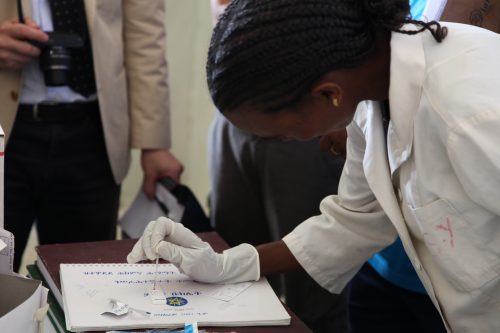A quick test for the presence of diseases such as Ebola and tuberculosis can save lives in remote and impoverished places

A female patient arrives at a rural clinic in Africa with a high fever. Its symptoms correspond to many diseases: from mild typhoid to Ebola. Even if it was possible to conduct blood tests on her, the results would only be available a few days later. What should the doctor do: give her antibiotics or send her to isolation?
Researchers have been working for a decade on developing cheap diagnostic tools on pieces of paper (similar to home pregnancy test kits) that could save lives in such situations. The first generation of this type of test means is now slowly approaching the commercial stage. an association named "Diagnosis for all"Awaiting the approval of the regulatory bodies to distribute in Africa a liver function diagnostic kit based on a blood sample. company Intellectual Ventures The company operating in Bellevue, Washington, is developing, with funding from the Bill and Melinda Gates Foundation, a highly sensitive malaria test, as well as a tool for diagnosing tuberculosis based on a urine sample. Paul Jaeger, a professor of biological engineering at the University of Washington, is developing a sensitive blood test to detect the Ebola virus protein. None of these devices cost more than a few dollars or require special training.
At the center of these diagnostic tools are strips of paper on which patterns are engraved or stamped that are used to separate, concentrate or mix liquids. Paper naturally absorbs liquids such as blood and urine due to a phenomenon called capillary flow, or capillarity. The samples thus pass through the paper on their own, with the patterns on the paper directing the sample liquid to the areas where it undergoes the necessary dilutions and the chemical reactions that enable the identification of pathogens. For example, the device for testing the liver functions of "Diagnostics for All" has a filter that blocks red blood cells and allows only the plasma to continue to a lower layer of paper, where there are substances that react with enzymes that indicate liver damage. The degree of color change in the paper indicates the level of these enzymes in the subjects' blood.
In the first generation of paper-based testing devices, the identification of diseases will usually be done by detecting unique molecules that are created in the body during infection or by the bacteria that cause the disease, but in later stages it is possible that test methods will also be developed that will directly identify the DNA of the pathogens themselves. Devices of this type, called nucleic acid tests, will allow doctors to accurately identify diseases in their earliest stages. Jaeger, together George Whitesides, professor of chemistry at Harvard University, and other researchers, are working on their own development of paper-based nucleic acid tests. Yager is developing a home test to detect the nucleic acids of the Zika virus and submitted an application for funding to develop fast and cheap tests for Zika, dengue fever and yellow fever.
The researchers still face technical challenges, but according to them, the biggest obstacle is the financial one. The pharmaceutical companies do not see high profits from facilities that cost so little, so most of the funding comes from government bodies and private foundations. "We and researchers after them have shown that the technology works," says Whitesides. "Much depends on our success in overcoming the last obstacle - making the technology commercial."

One response
Beautiful. They just need to add printing of electronic circuits on paper, with transistors, batteries and display means, a technology already in development and they will have an entire laboratory on a sheet of paper.